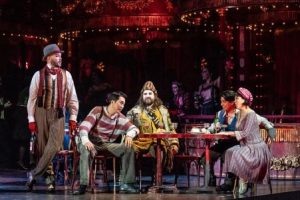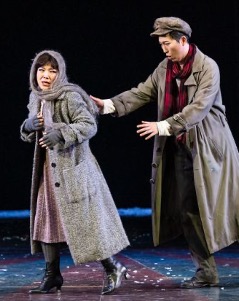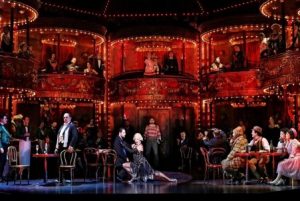By Giacomo Puccini. Opera Australia. Joan Sutherland Theatre, Sydney Opera House. Jan 12 – Mar 11, 2023
Reviewed : January 12, 2023 *

Though Giacomo Puccini set La Bohème in the busy, artistic Latin Quarter of Paris in 1896, director Gale Edwards saw how easily it could be transposed to Berlin in the1930s during the final licentious years of the Weimar Republic. That was a Berlin alive with street theatre, cabaret, jazz, innovative art, Bauhaus architecture … and very probably hopeful artists struggling to make a living, just like the artists Puccini created in La Bohème.
Those struggling artists – Marcello, a painter, Rudolfo, a writer, Colline, a philosopher and Schaunard, a musician – live in a gloomy atelier, where Marcello is painting The Parting of the Red Sea on the vast walls. It is winter, so cold that Rudolfo uses the pages of his latest story to light a fire. Schaunard arrives home with money (earned by playing his violin to a dying parrot) and some food, so they celebrate accordingly.

When their landlord Benoit arrives demanding overdue rent, they ply him with wine until he drunkenly confesses to an adulterous adventure. At this, they indignantly hunt him outside, share the rent money and set off for the Café Momus.
Rudolfo, fortuitously, stays behind and meets Mimi, who knocks on the door in search of a match to light her candle. They fall in love and eventually join the others, where Marcello re-ignites his love for the beautiful, flirtatious Musetta.
Café Momus gives Puccini, and designers Brian Thomson (set) and Julie Lynch (costumes) the opportunity to introduce a colourful market place of interesting characters and a change of tempo. In the busy square outside the café, hawkers flaunt their wares to interested shoppers – ‘Aranci, datteri! Caldi i marroni (Oranges, dates! Hot chestnuts!)’ – and children flock around Parpignol the toy seller. This scene is alive with glittering costumes, beautiful voices and bright music, especially Musetta’s risqué waltz, “Quando m’en vo (When I go along)”.
Passion and jealousy constantly divide and re-unite the lovers until, at last, they are together again, remembering their past happiness.

La Bohème is the consummate story of love found, love lost, and love regained. But this is opera, and unfortunately it is de rigueur for the ending to be unhappy. So, sadly, Mimi’s persistent illness eventually weakens her, and despite her friends’ comfort and Rudolfo’s reignited love, she succumbs to consumption and her beautiful voice quietly fades away.
This final scene is always desolate. In this production revival director Shaun Rennie and lighting designer John Rayment extend that image. With the high garret walls looming above her, Mimi lies on a low mattress centre stage. Rudolfo kneels at her side. When the others leave to give them some moments alone, Schaunard remains at the door, where light from the street throws his tall, protective shadow across the room shielding the lovers as they recall their former happiness and dreams.
Diminutive Karah Son returns as Mimi, with Iván Ayón Rivas as an adoring Rudolfo. Haotian Qi is a lithe, expressive Marcello and Julie Lea Goodwin reprises her sexy, provocative performance as Musetta. Alexander Sefton is a strong, confident Schaunard, and Richard Anderson returns as Colline. Andrew Moran is a very easily duped Benoit and though Benjamin Rasheed will play Parpignol in future performances, Tomas Dalton stepped very professionally into that role on opening night.

Puccini wrote to bring out the very best in the voices of his characters. Long, ringing notes tell of love and joy, heartbreak and delusion. Duets harmoniously bring lovers together – and draw them, pitifully, apart. The music of La Bohème is as well-known and loved as the characters and their stories, and in this production the Opera Australia Orchestra and conductor Michelangelo Mazza make it very special, particularly during the last sad moments of the production.
Picture Mimi’s very last breath, her hand falling limply. Picture Musetta, Marcello, Schaunard and Colline in a carefully blocked freeze of despair. Picture Rudolfo suddenly realising why. Then hear the orchestra come together with those last, crashing notes that explain more clearly than any words the complete desolation that he feels.

Gale Edwards and Shaun Rennie bring more than singing and music to this La Bohème. Moments are carefully and theatrically staged. There is depth in the acting as well. Iván Ayón Rivas and Haotian Qi establish the bond of good friends in the opening scenes, and the camaraderie of the friends as Schaunard and Colline return is as warm and uplifting as their singing. Julie Lea Goodwin is always expressive, and her Musetta is believably spirited. So too are the patrons and hawkers outside Café Momus, especially a very cheeky, pushy photographer!
Opera Australia continues to thrill as it uses new energies and technologies to augment the magical beauty of music that surpasses time and change.
First published in Stage Whispers magazine
*Opening Night